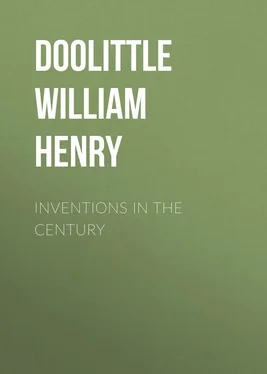William Doolittle - Inventions in the Century
Здесь есть возможность читать онлайн «William Doolittle - Inventions in the Century» — ознакомительный отрывок электронной книги совершенно бесплатно, а после прочтения отрывка купить полную версию. В некоторых случаях можно слушать аудио, скачать через торрент в формате fb2 и присутствует краткое содержание. Жанр: foreign_antique, foreign_prose, на английском языке. Описание произведения, (предисловие) а так же отзывы посетителей доступны на портале библиотеки ЛибКат.
- Название:Inventions in the Century
- Автор:
- Жанр:
- Год:неизвестен
- ISBN:нет данных
- Рейтинг книги:5 / 5. Голосов: 1
-
Избранное:Добавить в избранное
- Отзывы:
-
Ваша оценка:
- 100
- 1
- 2
- 3
- 4
- 5
Inventions in the Century: краткое содержание, описание и аннотация
Предлагаем к чтению аннотацию, описание, краткое содержание или предисловие (зависит от того, что написал сам автор книги «Inventions in the Century»). Если вы не нашли необходимую информацию о книге — напишите в комментариях, мы постараемся отыскать её.
Inventions in the Century — читать онлайн ознакомительный отрывок
Ниже представлен текст книги, разбитый по страницам. Система сохранения места последней прочитанной страницы, позволяет с удобством читать онлайн бесплатно книгу «Inventions in the Century», без необходимости каждый раз заново искать на чём Вы остановились. Поставьте закладку, и сможете в любой момент перейти на страницу, на которой закончили чтение.
Интервал:
Закладка:
Dentistry. – This art has been revolutionised during the century. Even in the time of Herodotus, one special set of physicians had the treatment of teeth; and artificial teeth have been known and used for many ages, but all seems crude and barbarous until these later days. In addition to the use of anaesthetics, improvements have been made in nearly every form of dental instruments, such as forceps, dental engines, pluggers, drills, hammers, etc., and in the means and materials for making teeth. Later leading inventions have reference to utilising the roots of destroyed teeth as supports on which to form bridges to which artificial teeth are secured, and to crowns for decayed teeth that still have a solid base.
There exists no longer the dread of the dentist's chair unless the patient has neglected too long the visit. Pain cannot be all avoided, but it is ameliorated; and the new results in workmanship in the saving and in the making of teeth are vast improvements over the former methods.
CHAPTER VII.
STEAM AND STEAM ENGINES
"Soon shall thy arm, unconquered steam! afar
Drag the slow barge, or drive the rapid car;
Or in wide waving wings expanded bear
The flying chariot through the field of air."
Thus sang the poet prophet, the good Dr. Darwin of Lichfield, in the eighteenth century. Newcomen and Watt had not then demonstrated that steam was not unconquerable, but the hitching it to the slow barge and the rapid car was yet to come. It has come, and although the prophecy is yet to be rounded into fulfilment by the driving of the "flying chariot through the field of air," that too is to come.
The prophecy of the doctor poet was as suggestive of the practical means of carrying it into effect as were all the means proposed during the first seventeen centuries of the Christian Era for conquering steam and harnessing it as a useful servant to man.
Toys, speculations, dreams, observations, startling experiments, these often constitute the framework on which is hung the title of Inventor; but the nineteenth century has demanded a better support for that proud title. He alone who first transforms his ideas into actual work and useful service in some field of man's labor, or clearly teaches others to do so, is now recognised as the true inventor. Tested by this rule there was scarcely an inventor in the field of steam in all the long stretches of time preceding the seventeenth century. And if there were, they had no recording scribes to embalm their efforts in history.
We shall never know how early man learned the wonderful power of the spirit that springs from heated water. It was doubtless from some sad experience in ignorantly attempting to put fetters on it.
The history of steam as a motor generally commences with reference to that toy called the aeolipile, described by Hero of Alexandria in a treatise on pneumatics about two centuries before Christ, and which was the invention of either himself or Ctesibius, his teacher.
This toy consisted of a globe pivoted on two supports, one of which was a communicating pipe leading into a heated cauldron of water beneath. The globe was provided with two escape pipes on diametrically opposite sides and bent so as to discharge in opposite directions. Steam admitted into the globe from the cauldron escaped through the side pipes, and its pressure on these pipes caused the globe to rotate.
Hero thus demonstrated that water can be converted into steam and steam into work.
Since that ancient day Hero's apparatus has been frequently reinvented by men ignorant of the early effort, and the principle of the invention as well as substantially the same form have been put into many practical uses. Hero in his celebrated treatise described other devices, curious siphons and pumps. Many of them are supposed to have been used in the performance of some of the startling religious rites at the altars of the Greek priests.
From Hero's day the record drops down to the middle ages, and still it finds progress in this art confined to a few observations and speculations. William of Malmesbury in 1150 wrote something on the subject and called attention to some crude experiments he had heard of in Germany. Passing from the slumber of the middle ages, we are assured by some Spanish historians that one Blasco de Garay, in 1543, propelled a ship having paddle wheels by steam at Barcelona. But the publication was long after the alleged event, and is regarded as apocryphal.
Observations became more acute in the sixteenth and seventeenth centuries, experiments more frequent, and publications more full and numerous.
Cardan Ramelli and Leonardo da Vinci, learned Italians, and the accomplished Prof. Jacob Besson of Orleans, France, all did much by their writings to make known theoretically the wonderful powers of steam, and to suggest modes of its practical operation, in the latter part of the sixteenth century.
Giambattista della Porta, a gentleman of Naples, possessing high and varied accomplishments in all the sciences as they were known at that day, 1601, and who invented the magic-lantern and camera obscura , in a work called Spiritalia , described how steam pressure could be employed to raise a column of water, how a vacuum was produced by the condensation of steam in a closed vessel, and how the condensing vessel should be separated from the boiler. Revault in France showed in 1605 how a bombshell might be exploded by steam.
Salomon de Caus, engineer and architect to Louis XIII, in 1615 described how water might be raised by the expansion of steam.
In 1629 the Italian, Branco, published at Rome an account of the application of a steam jet upon the vanes of a small wheel to run it, and told how in other ways Hero's engine might be employed for useful purposes.
The first English publication describing a way of applying steam appeared in 1630 in a patent granted to David Ramseye, for a mode of raising water thereby. This was followed by patents to Grant in 1632 and to one Ford in 1640. During that century these crude machines were called "fire engines." It seems to have been common in some parts of Europe during the seventeenth century to use a blast of steam to improve the draft of chimneys and of blast furnaces. This application of steam to smoke and smelting has been frequently revived by modern inventors with much flourish of originality.
It is with a certain feeling of delight and relief, after a prolonged search through the centuries for some evidence of harnessing this mighty agent to man's use, that we come to the efforts of the good Marquis of Worcester – Edward Somerset. He it was who in 1655 wrote of the Inventions of the Sixteenth Century . He afterwards amplified this title by calling his book A Century of Names and Scantlings of such Inventions as at present I call to mind to have tried and perfected , etc.
There are about one hundred of these "Scantlings," and his descriptions of them are very brief but interesting. Some, if revived now and put to use, would throw proposed flying machines into the background, as they involved perpetual motion.
But to his honor be it said that he was the first steam-engine builder. A patent was issued to him in 1663. It was about 1668 that he built and put in successful operation at Raglan Castle at Vauxhall, near London, a steam engine to force water upward. He made separate boilers, which he worked alternately, and conveyed the steam from them to a vessel in which its pressure operated to force the water up. Unfortunately he did not leave a description of his inventions sufficiently full to enable later mechanics to make and use them. He strove in vain to get capital interested and a company formed to manufacture his engines. The age of fear and speculation as to steam ceased when the Marquis set his engine to pumping water, and from that time inventors went on to put the arm of steam to work.
Читать дальшеИнтервал:
Закладка:
Похожие книги на «Inventions in the Century»
Представляем Вашему вниманию похожие книги на «Inventions in the Century» списком для выбора. Мы отобрали схожую по названию и смыслу литературу в надежде предоставить читателям больше вариантов отыскать новые, интересные, ещё непрочитанные произведения.
Обсуждение, отзывы о книге «Inventions in the Century» и просто собственные мнения читателей. Оставьте ваши комментарии, напишите, что Вы думаете о произведении, его смысле или главных героях. Укажите что конкретно понравилось, а что нет, и почему Вы так считаете.












